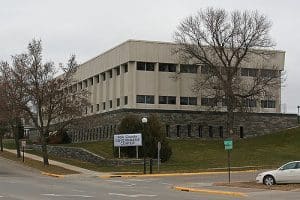Polk County held its Truth in Taxation presentation and public hearing on Tuesday night in the Polk County Government Center.
Polk County commissioners and representatives attended the meeting along with twelve Polk County residents as they sat in on Polk County Administrator Chuck Whiting’s budget/levy presentation.
The presentation included the levy being set at 2.5%, which equates to an approximate increase of $672,443. The county is expected to see expenditures total just shy of 75 million dollars in 2024, and the net levy is set at $27.5 million.
Whiting’s presentation also showed the revenue breakdown for the county heading into 2024, which included 37% of revenue coming via property taxes in the amount of $27.5 million and the roads and bridges projects to be responsible for 24% of the $17.6 million dollar payment.
The Polk County residents who attended did not challenge the budget and levy itself; however, there were many questions about assessed valuations and home value increases. Gloria Carver of Mcintosh shared her concerns about increasing property taxes by 600% due to a homestead credit issue. “It’s not so much the valuations, but it somehow went up 600%,” said Carver, “Part of it is the homestead credit, which doubles the taxes. But I’m still unsure why they must add what the homestead was when you don’t have it.”
Eric Sorenson of Bygland expressed to the county representatives his confusion about how the value of his home has gone up nearly $130,000 since 2021 and how that has affected his tax statements heading into 2024. “The value of our property has gone up the past few years to me; it’s unrealistic,” said Sorenson, “We live in an old farmhouse, and our property is in a position where unless you’re prepared to take on some challenges in the winter and possess the equipment to clear out a long driveway, the value to me is just unrealistic.”
Sorenson also explained to the county workers that his home shouldn’t be estimated at the same value as newer homes, which will ultimately make it more difficult to sell when the time comes. “Unless you’re looking to sell, it only hurts us. We have an old farmhouse, and we love it,” said Sorenson, “But it’s not worth as much as a newer home that was built 20-30 years ago, so that was my concern and what we discussed. I’m afraid that’s not right.”
Mark Schmitz of Fosston, like Sorenson, expressed his concerns with the massive increase in the value of his home in contrast to previous years. “You typically see taxes increase a couple of hundred dollars a year, and then all of a sudden, you get the shock of a $110,000 increase on your home,” said Schmitz, “It’s going to draw to you to wonder what is going on and why your home state has to follow the crazy markets when dealing with tax dollars. In my opinion, when dealing with people’s tax dollars, you should try to avoid the crazy volatility that happens on the private side.”
The Polk residents who attended this meeting had questions and concerns similar to the three featured, and many wanted to know why and how the valuations and home values increased as much as they did. Polk County Assessor Mark Landsverk was able to explain the 2024 home values.
“When doing these valuations, we try to find a mid-point (per township). If there are nine sales in a jurisdiction, we look at the fifth one. Four of them above and four of them below” said Landsverk, “This is the sale percentage, which is our value compared to the sales price. So if our value was $90,000 and it sold for $100,000, the ratio would be 90%.”
According to state statute, when finding the township (ratio), counties have to be within 90-105% compared to the rest of the state. Landsverk also mentioned that rural areas in Minnesota generally experience a 20% increase in property value, and the residential regions throughout Polk County have seen a rise of 16%. However, depending on home sales per township, these increases vary.












